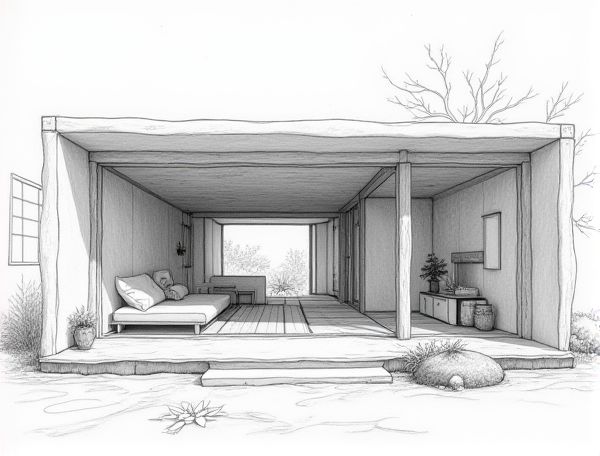
Photo illustration: Japanese Sukiya home design with tatami mat rooms
Sukiya home design emphasizes simplicity, natural materials, and harmonious integration with nature, featuring iconic tatami mat rooms that create a serene and balanced living space. Explore the article to discover how you can incorporate traditional Japanese aesthetics into your own home design.
Introduction to Japanese Sukiya Home Design
Sukiya home design emphasizes natural materials, minimalism, and harmonious integration with the surrounding environment, reflecting traditional Japanese aesthetics. Your space will embody tranquility through features like tatami mats, sliding shoji doors, and carefully crafted wooden elements.
Historical Origins of Sukiya Architecture
Sukiya architecture, originating in 16th-century Japan during the Momoyama period, reflects the refined aesthetics of traditional tea houses with its emphasis on natural materials, simplicity, and harmony with nature. Your home design can incorporate Sukiya elements like exposed wooden beams, tatami flooring, and sliding shoji screens to evoke an atmosphere of tranquility and timeless elegance.
Key Principles of Sukiya Aesthetics
Sukiya aesthetics emphasize simplicity, natural materials, and harmonious integration with the surrounding environment, creating a tranquil and balanced living space. Your home design should incorporate elements like wood, paper, and stone to evoke warmth and authenticity while maintaining minimal ornamentation. Careful attention to proportion, subtle asymmetry, and seasonal changes enhances the emotional connection and timeless beauty of the Sukiya style.
Role of Tatami Mats in Japanese Interiors
Tatami mats, traditionally crafted from rice straw and woven rush, play a crucial role in defining Japanese interiors by providing a natural, textured flooring that regulates humidity and promotes a calming atmosphere. Your home design benefits from incorporating tatami mats, as they enhance spatial harmony and support cultural authenticity in modern living spaces.
Spatial Organization in Sukiya Homes
Spatial organization in Sukiya homes emphasizes fluidity and harmony between indoor and outdoor spaces, creating a balanced environment that enhances your living experience. The design incorporates natural elements through strategic placement of rooms, allowing for seamless transitions and maximizing natural light and ventilation. This meticulous arrangement fosters tranquility and functionality, making every space purposeful and connected.
Natural Materials and Minimalist Décor
Natural materials like wood, stone, and bamboo bring warmth and texture to minimalist decor, creating a calming and organic atmosphere in your home. Emphasizing clean lines, uncluttered spaces, and neutral color palettes enhances the natural beauty of these materials while promoting simplicity and functionality. Your space will feel both modern and inviting by integrating sustainable elements with minimalist design principles.
Integration of Indoor and Outdoor Spaces
Creating seamless transitions between indoor and outdoor spaces enhances Your home's aesthetic appeal and functional living area. Incorporating large sliding glass doors, natural materials, and consistent color palettes strengthens the connection between interior rooms and outdoor patios or gardens. Thoughtful integration increases natural light, promotes ventilation, and expands Your usable living environment.
Sliding Doors and Flexible Room Layouts
Sliding doors maximize space efficiency by eliminating the need for traditional swing areas, enhancing room functionality and flow. Flexible room layouts paired with sliding doors allow seamless transformation of living spaces, catering to evolving needs and preferences. Incorporating these elements boosts natural light distribution and provides versatile boundary options for modern home design.
Contemporary Adaptations of Sukiya Design
Contemporary adaptations of Sukiya design emphasize clean lines, natural materials, and seamless indoor-outdoor flow to create a serene living environment. Integrating traditional Japanese elements like tatami mats and shoji screens with modern minimalism enhances both functionality and aesthetic appeal. Your home can achieve a balanced harmony by blending timeless Sukiya principles with innovative design techniques.
Tips for Creating a Tatami Room in Modern Homes
Incorporate traditional tatami mats made from woven straw for authentic texture and warmth, while using minimalist furniture to maintain a sleek, modern aesthetic. Optimize natural light with sliding shoji screens and integrate built-in storage solutions to maximize space efficiency in small to medium-sized rooms.
 homedesy.com
homedesy.com